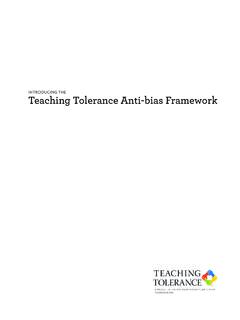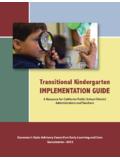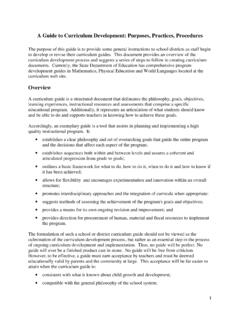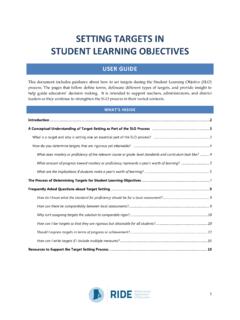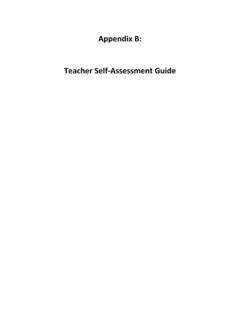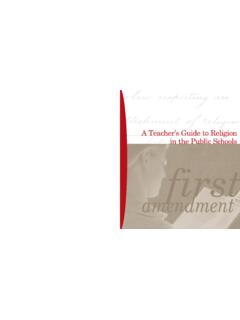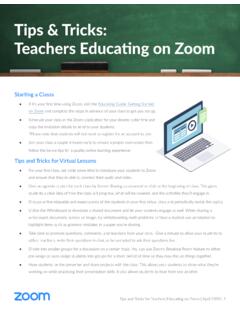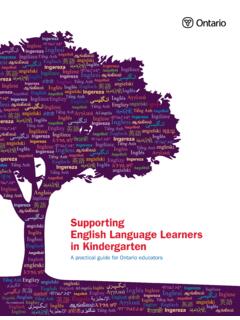Transcription of a guide for administrators, counselors and teachers ...
1 Teaching tolerance // responding to hate and bias at school ia guide for administrators, counselors and teachersResponding to Hate and Bias at scHoola publication of teaching guide for administrators, counselors and teachersResponding to Hate and Bias at scHoola publication of teaching tolerance // responding to hate and bias at school 1 Table of ConTenTsPreface 2seCTion one // before a Crisis oCCurs 3 What is the School s Climate? 4administrators precrisis checklistListen, Watch and Learn 5 Stay Current, Stay Connected 6 Set High Expectations 7 Make the Most of Teachable Moments 7 Speak Up 9seCTion Two // when There s a Crisis 10 What Has Happened? 11administrators crisis checklistPut Safety First 14 Denounce the Act 14 Investigate 15 Involve Others 16 Work with the Media 17 Provide Accurate Information and Dispel Misinformation 20 Support Targeted Students 20 Seek Justice, Avoid Blame 21 Promote Healing 22seCTion Three // afTer The worsT is over 23 What Comes Next?
2 24administrators postcrisis checklistLessons Learned 25 Planning for the Long Term 26 Capacity Building 26appendix // CheCklisTs, forms and worksheeTs 28 Acknowledgments 41teaching tolerance // responding to hate and bias at school 2prefaceResponding to Hate and Bias at scHoola noose is found hanging from a goalpost on a high school campus. a swastika, 20 feet in diameter, is burned into the pavement at a junior high group of white high school students dresses in banana suits for a basketball game and taunts their majority-black rival with racial slurs. a sikh student has his turban pulled off and hair cut by fellow school has plans and protocols in place to respond to fires, severe weather, medical emergencies, fights and weapons possession. But what about school incidents like those listed above that involve big-otry and hate?
3 Are plans in place to respond to a bias incident or hate crime? Too often these plans are created in the moment during the actual crisis. Bias incidents are far too complex for on-the-fly planning; an early misstep can heighten tension and damage chances for long-term to bias and hate at school is designed primarily for school administrators, but teachers , staff, counselors , students and others also may find guidance here. The guide is divided into three sections:before a Crisis oCCurs. How can you and other school leaders assess your school s climate with an eye toward defusing tension, preventing escalation and avoiding problems?when There s a Crisis. What are the nine key points to consider when responding to a crisis that has been triggered by a bias incident at your school?
4 AfTer The worsT is over. How can you address long-term planning and capacity building for the future, including development of social emotional skills? Hateful acts at school are dangerous, disturbing and disruptive. But keep this in mind: A bias incident does not define a school. It is, in many ways, a test of the school s culture and climate. How you respond is the true measure of a school s character. It s up to school leaders to set expectations. Everyone on staff, from the bus driver and custodian to classroom teachers and the IT department, must know that hate, disrespect and intimidation have no place on campus, and that every student should feel tolerance // responding to hate and bias at school 3 Section oneteaching tolerance // responding to hate and bias at school 4 WHat is tHe scHool s climate?
5 Unsavory pranks, bias incidents and even hate crimes can happen at any school, anywhere rural, urban, suburban, public, private, small, large, East, West, North or South. Sometimes they arrive as a complete surprise; other times, they arise from tension that has been brewing for weeks, months, even years. So what is the climate at your school?Everyday acts of intolerance manifest themselves in many ways: name-calling, slurs, sexual harass-ment, casual putdowns regarding race, ethnicity, gender, size, abilities, perceived sexual orientation or gender identification. The bias might come in the form of clothing certain colors or styles or music or symbols associated with hate groups. Growing intolerance can also be found online, posted on Tumblr or tweeted on Twitter. It might be blatant, such as a noose left hanging from an African-American student s locker.
6 Or it might be subtle, a hushed rumor texted like a whisper, phone to phone, person to person. In some cases, the viciousness is intentional; in others, perpetrators might have little clue other than shock value about the meaning behind the words, signs and symbols they shout, tweet, paint or text. In many ways, the issue is less about intent who can know for certain why someone does something? and more about impact. No matter the intention, these messages and behaviors can cause fear, damage and injury to individuals and the entire school can educators deal with this? The adults at any school teach in so many ways, far beyond text-books and lesson plans. They teach by example, by the tone and words they choose, by how they treat others during moments of disagreement or tension.
7 They teach by what they don t say. If, for example, they allow a bigoted comment to go unchecked, they are offering tacit approval of similar comments. A school climate that encourages inclusion and promotes tolerance does not guarantee that bias inci-dents won t happen. Instead, it creates an atmosphere in which these acts are less likely to gain momen-tum and more likely to be quickly and widely denounced. teaching tolerance // responding to hate and bias at school 5administrators precrisis checklist lisTen, waTCh and learnWhen you walk the halls or spend time in the cafeteria wherever you are on campus be alert. Are you hearing putdowns and slurs? Do you notice tense or fearful looks between some groups of students? These are early warning signs of potential trouble. Unacknowledged and unchal-lenged, these attitudes and behaviors can set the stage for worse to come.
8 Safety, of course, is your first concern. Are direct threats being made? Is danger imminent? These situations may require immediate action. More general, indirect behaviors indicate that there might be a problem with the school s climate. Is this the type of school you want? Pose that question to students, teachers , parents and staff, and listen closely to the answers. Take notes. Identify patterns. Be the person who knows what s really going on at your more thing: Make sure your staff members exercise the same vigilance in classrooms, playgrounds, the cafeteria, buses everywhere. Being alert is the responsibility of everyone on campus, and everyone has a duty to report problems they see and hear. Make this an expectation and set up an efficient reporting system, like an anonymous complaint box or a designated staff member.
9 After problems are reported, there must be clear signs of s a checklist to consider as you travel the halls, classrooms and school grounds:Casual pejoraTives. Do you hear certain words used regularly in a derogatory manner? That s so gay. That s lame. That s retarded. Is the word bitch used casually to label female students? Work to establish a climate where casual slurs are uncommon and are challenged when they do occur. speak up at school offers advice on responding to everyday bias ( ).sChool pride. Do cheers and chants at sporting events focus on positive aspects of your school, or do they demean opponents instead? Chants or taunts based on ethnic stereotypes and socioeco-nomic differences have no place in an inclusive school community. assemblies and holidays. Skits and costumes can convey bigoted and stereotypical messages: the day-laboring Mexican, students dressed as rednecks, people in blackface.
10 Pep rallies, Halloween and other events, like spirit days, can become steeped in stereotypes and bigotry. Set expectations beforehand about appropriate costumes and cultural sensitivity. Discuss the inappropriateness of caricatures or disturbing representations that are rooted in bias and bigotry. marginalized sTudenTs. Engage students who appear to be left out in the cafeteria, on the play-ground or in other school settings. Watch for patterns or changes in the way groups of students are aligned. Check for signs of hostility, depression or a marked change in behavior or academic performance, and reach out to the students parents or guardians and/or the school counselor as appropriate. Alienated students either as individuals or in groups are more susceptible to bias-based bullying and even to recruitment by gangs and hate reCogniTion.



